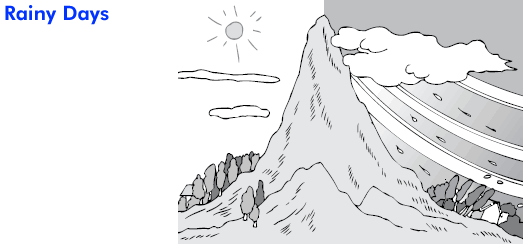 |
|
スクリプト How big is a raindrop? About 0.5 mm in size. It takes a lot of raindrops to fill a cup! The average rainfall in Tokyo is about 1,400 mm a year. That is twice as much as most places in Europe. But Cherrapundi in India had 9,300 mm of rain in one month! As for dry places, Arica in Chile gets only about 0.8 mm of rain a year. I am sure they would like to have more rainy days.
1. dry places 2. rain 3. the North Pole 4. moisture 5. Arica
A. 次の質問の答えとして適切なものを選ぼう。 1. Why is the North Pole very dry? 2. How much rain do most places in Europe get in a year? B. 左の数字に関係のある記述を選んで線で結んでみよう。
スクリプト Joey was going to visit his aunt in the city and took Lucky. At first, the dog enjoyed the ride, but in the city, he barked at the big buildings. He seemed afraid. When they arrived at Joey’s aunt’s house, Lucky ran into the street. There was the terrible noise of car brakes. Lucky had been hit! He was dead. Joey felt terrible. He cried and cried. The family decided to go home, but the dead dog was left behind. When they arrived home, Joey walked sadly through the fields. Without thinking, he went up the hill to Bobby’s house. When he arrived, Bobby came out and said, “Where’s Lucky? I saw him walking behind you up the hill.”
1. Lucky was hit by a car. Maybe Lucky is still with me.
|
|
||||||||||||||||||||||||||||||||||||||||||||||||||||||||||||||||||||||||||||||||||||||||||||||||||||||||||||||||||||||||||||||||||||||||||||||||||||||







